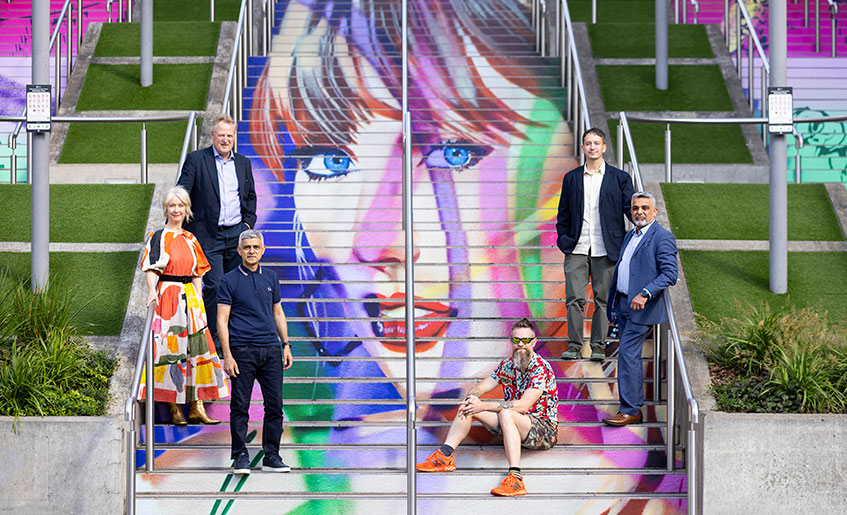When Taylor comes to town – a developer’s TAYke-away
COMMENT When Quintain submitted masterplans for Wembley Park more than 20 years ago, we felt revolutionary.
Elsewhere, the likes of Chiswick Park were hailed as urban campus successes in London, creating big office floorplates with strong amenities, public realm and an enjoy-work mindset. Wembley Park, in contrast, was to be one of the biggest single-ownership sites in London, delivering a new, truly mixed-use masterplan. Our vision for Wembley Park was always to create a 365-day neighbourhood where people would choose to live, work and connect.
Today almost all new and regeneration developments are mixed-use in nature, but 20 years ago offices remained largely in office locations, and homes similarly in residential postcodes. High streets were for shopping, and side-streets for drinking and eating.
COMMENT When Quintain submitted masterplans for Wembley Park more than 20 years ago, we felt revolutionary.
Elsewhere, the likes of Chiswick Park were hailed as urban campus successes in London, creating big office floorplates with strong amenities, public realm and an enjoy-work mindset. Wembley Park, in contrast, was to be one of the biggest single-ownership sites in London, delivering a new, truly mixed-use masterplan. Our vision for Wembley Park was always to create a 365-day neighbourhood where people would choose to live, work and connect.
Today almost all new and regeneration developments are mixed-use in nature, but 20 years ago offices remained largely in office locations, and homes similarly in residential postcodes. High streets were for shopping, and side-streets for drinking and eating.
We have come a long way in 20 years, with the desire for mixed uses in our towns and cities accelerated further during the Covid-19 pandemic, which refocused everyone on local. At Wembley Park, being dynamic to social changes has been the lynchpin to our ongoing success at attracting residents and visitors and it is this drive to stay relevant that influences the blend of retail, leisure and living we offer today.
What makes Wembley Park unique from other new neighbourhoods in London, however, is our globally renowned entertainment district, that coexists with our residential community. We host a variety of world-class venues, including Wembley Stadium, Ovo Arena Wembley, Troubadour Theatre and Boxpark Wembley and welcome more than 16m visitors annually. This summer alone we are expecting more than 4m visitors from the UK and beyond with the arrival of Taylor Swift’s Eras Tour and our packed retail and events programme around the wider estate.
The Eras Tour is expected to generate £300m for the capital’s economy. At London Designer Outlet at Wembley Park we are expecting “Black Friday” levels of shoppers this week, with sales double what they are usually. We will wait and see if Swift can beat our reigning champion, Ed Sheeran – closely followed by Pink and Harry Styles – in terms of visitor footfall and retail spend across our shops and restaurants. With London boasting the most shows of any city on the superstar’s global tour, it reminds us that the UK capital is a global hub for music and I am incredibly proud that Wembley Park plays a fundamental role in maintaining this enviable reputation.
Ahead of the first London performance we welcomed mayor of London Sadiq Khan, alongside Justine Simons, deputy mayor for culture and the creative industries and Mo Butt of Brent Council, to unveil two new public artworks. With the artists, Frank Styles and MurWalls & Humor, also there, it was a wonderful moment to celebrate what Wembley Park has become.
The artwork, along with a public photographic gallery displaying images of the Eras Tour – available to view from now until September – forms part of our ambition to bring the benefits of our global entertainment status to our wider community at Wembley Park.
Entertainment is part of our identity, it makes us stand out from other neighbourhoods in London, it attracts ever more residents and visitors, and it gives us our north star from which we can curate public art and activities for all to learn from.
Community can mean different things to different people in 2024. Whether you resonate with the community of “Swifties” who can make the earth move, if the press is to be believed, or your community closer to home.
At Quintain, we try to put community and people first in everything we do. We recognise that we have a responsibility to leave a positive and lasting legacy on the people we work with and the places we develop. It is fantastic that Wembley can draw international stars like Swift – or Bruce Springsteen later this year – and can bring football fans together to watch the FA Cup Final or Champions League. But part of our role is to be responsible for passing some of the benefits that come with these moments on to the wider community who live at Wembley Park and the surrounding area year-round – whether through public access, free art displays, better shops and restaurants, or job opportunities.
So as the queues grow for each of Swift’s performances at Wembley Stadium, so too will the crowds of local people who congregate in our safe and inclusive public spaces to soak up the atmosphere and vibe of the area.
James Saunders is chief executive of Wembley Park and Quintain
Photo courtesy of London Communications Agency











